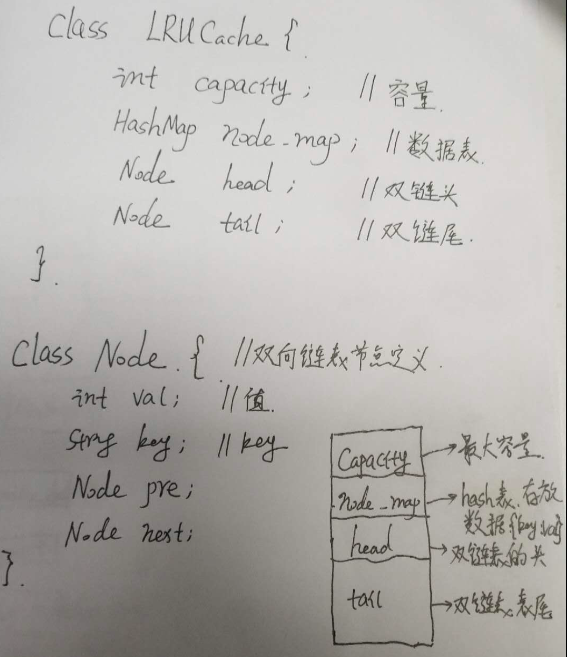LRU缓存机制
一、题目描述
1、English版本
Design and implement a data structure for Least Recently Used (LRU) cache. It should support the following operations: get and put.
get(key) - Get the value (will always be positive) of the key if the key exists in the cache, otherwise return -1.
put(key, value) - Set or insert the value if the key is not already present. When the cache reached its capacity, it should invalidate the least recently used item before inserting a new item.
Follow up:
Could you do both operations in O(1) time complexity?
Example:
LRUCache cache = new LRUCache( 2 /* capacity */ ); cache.put(1, 1); cache.put(2, 2); cache.get(1); // returns 1 cache.put(3, 3); // evicts key 2 cache.get(2); // returns -1 (not found) cache.put(4, 4); // evicts key 1 cache.get(1); // returns -1 (not found) cache.get(3); // returns 3 cache.get(4); // returns 4
2、 中文版
运用你所掌握的数据结构,设计和实现一个 LRU (最近最少使用) 缓存机制。它应该支持以下操作: 获取数据 get 和 写入数据 put 。
获取数据 get(key) - 如果密钥 (key) 存在于缓存中,则获取密钥的值(总是正数),否则返回 -1。
写入数据 put(key, value) - 如果密钥不存在,则写入其数据值。当缓存容量达到上限时,它应该在写入新数据之前删除最近最少使用的数据值,从而为新的数据值留出空间。
进阶:
你是否可以在 O(1) 时间复杂度内完成这两种操作?
示例:
LRUCache cache = new LRUCache( 2 /* 缓存容量 */ ); cache.put(1, 1); cache.put(2, 2); cache.get(1); // 返回 1 cache.put(3, 3); // 该操作会使得密钥 2 作废 cache.get(2); // 返回 -1 (未找到) cache.put(4, 4); // 该操作会使得密钥 1 作废 cache.get(1); // 返回 -1 (未找到) cache.get(3); // 返回 3 cache.get(4); // 返回 4
二、ruby方案
采用双向链表作为LRU索引表,采用哈希表作为数据表。
当容量满时,从索引表移除第一项,再从哈希表删除元素。每次插入元素或获取元素时,都要从索引表中删除索引,再重新插入索引。
由于是双向链表,并且已经保存了索引的节点,因此对索引的操作是o(1),而存储数据的hash表也是o(1),所以理论上整体操作是o(1)。

如图,LRU是最近最少使用,所以使用双向链表,将最近最少使用的数据放在表头移除元素时可以实现O(1);
而读取则使用hash作为数据表,读取之后移除该元素;
代码如下:
# 采用双向链表作为LRU索引表,采用哈希表作为数据表
# 当容量满时,从索引表移除第一项,再从哈希表删除元素。
# 每次插入元素或获取元素时,都要从索引表中删除索引,再重新插入索引。
# 由于是双向链表,并且已经保存了索引的节点,因此对索引的操作是o(1),而存储数据的hash表也是o(1),所以理论上整体操作是o(1)。
class Node
def initialize(key, val)
@val = val
@key = key
@pre = nil
@next = nil
end
end
class LRUCache
=begin
:type capacity: Integer
=end
def initialize(capacity)
@capacity = capacity
@node_map = {}
@head = nil
@tail = nil
end
=begin
:type key: Integer
:rtype: Integer
=end
def get(key)
if @node_map.keys.include? key
return -1
end
node = @node_map[key]
if !node.next.nil?
if node.pre.nil?
@head = @head.next
@head.pre = nil
else
node.pre.next = node.next
node.next.pre = node.pre
end
@tail.next = node
node.pre = @tail
node.next = nil
@tail = node
end
node.val
end
=begin
:type key: Integer
:type value: Integer
:rtype: Void
=end
def put(key, value)
if @node_map.keys.include? key
@node_map[key].val = value
get(key)
return
end
if @node_map.keys.size == @capacity
node = @node_map[head.key]
@node_map.delete(head.key)
@node_map[key] = value
node.val = value
node.key = key
get(key)
else
node = Node.new(key, value)
@node_map[key] = node
if @head.nil?
@head = node
@tail = node
else
@tail.next = node
node.pre = @tail
@tail = node
end
end
end
end
# Your LRUCache object will be instantiated and called as such:
# obj = LRUCache.new(capacity)
# param_1 = obj.get(key)
# obj.put(key, value)
